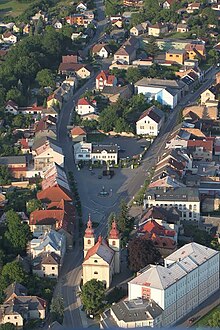Vamberk
| Vamberk | ||||
|---|---|---|---|---|
|
||||
| Basic data | ||||
| State : |
|
|||
| Region : | Královéhradecký kraj | |||
| District : | Rychnov nad Kněžnou | |||
| Area : | 2103 ha | |||
| Geographic location : | 50 ° 7 ' N , 16 ° 17' E | |||
| Height: | 320 m nm | |||
| Residents : | 4,532 (Jan 1, 2019) | |||
| Postal code : | 517 54 | |||
| traffic | ||||
| Railway connection: | Doudleby nad Orlicí – Rokytnice v Orlických horách | |||
| structure | ||||
| Status: | city | |||
| Districts: | 3 | |||
| administration | ||||
| Mayor : | Rudolf Futter (as of 2018) | |||
| Address: | Husovo náměstí 1 517 54 Vamberk |
|||
| Municipality number: | 576883 | |||
| Website : | www.vamberk.cz | |||
Vamberk (German Wamberg ) is a town in Okres Rychnov nad Kněžnou (Reichenau an der Knieschna) in the Hradec Králové region in the Czech Republic . It is located four kilometers south of Rychnov nad Kněžnou in the valley of the Zdobnice River .
history
The place was first mentioned in 1341 as the castle seat Waldenberg , around 1400 as Walmberg and later as Wamberg . Wamberg was the seat of the lordship of the same name , which was divided in the 16th century and reunited under the owner Wenceslaus Pencingár von Bydžin. Because of his participation in the Bohemian uprising of 1618, the emperor confiscated the lords of Wamberg and Adlerkosteletz after the battle of the White Mountain and in 1627 transferred both to Kaspar von Gramb, imperial colonel and court war councilor. His wife Magdalena Reichlin Freiin von Gramb († 1671) obtained the Bohemian Inkolat on January 19, 1636 as well as the confirmation of the baron status . She tried to improve the living conditions of her subjects. As early as 1637 she had largely abolished compulsory labor , and she also promoted lace-making . Due to the subsequent economic upswing, Wamberg was elevated to a market town in the second half of the 17th century.
There is evidence of a Jewish community for 1654 and a Jewish cemetery for 1688, where Jews from the surrounding communities Daudleb and Adlerkosteletz were also buried.
The textile industry developed in Wamberg in the 18th and 19th centuries; Metal processing companies were added in the 20th century. The population increased only slowly. In 1826 there were 1844, 1900 3074 and 1980 5435 inhabitants.
Attractions
- The baroque deanery church St. Prokop was built 1707-1713.
- The cemetery church dedicated to St. Barbara dates from the end of the 17th century.
- Museum of lace making
- Jewish cemetery from the 17th century
Community structure
The districts belong to the city of Vamberk
- Merklovice ( Merklowitz )
- Peklo nad Zdobnicí ( Hell's Ground ) with Libštejn ( Liebstein ), Hradisko ( Radisch ) and Zakopánka ( Schanzen )
- Vamberk with Popluží ( Vorberg ) and Zádolí ( Sadol )
Personalities
- Josef Kalousek (1838–1915), historian
- Jan Václav Voříšek (1791–1825), composer
literature
- Joachim Bahlcke , Winfried Eberhard, Miloslav Polívka (eds.): Handbook of historical places . Volume: Bohemia and Moravia (= Kröner's pocket edition . Volume 329). Kröner, Stuttgart 1998, ISBN 3-520-32901-8 , p. 646.
Web links
Individual evidence
- ↑ Český statistický úřad - The population of the Czech municipalities as of January 1, 2019 (PDF; 7.4 MiB)
- ^ Procházka novel : Genealogical handbook of extinct Bohemian gentry families. Degener, Neustadt an der Aisch 1973, ISBN 3-7686-5002-2 , p. 360.


